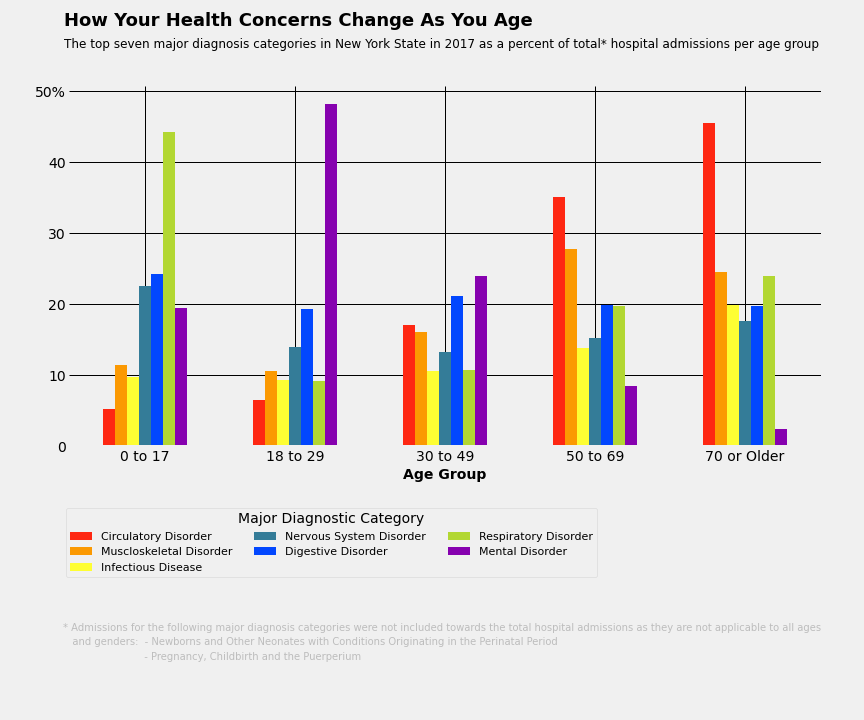Mental Health: Top Cause for Hospital Admissions for Young and Middle-aged Adults
Comparing the prevalence of hospital inpatient admissions for top major health categories in New York State in 2017
By Steven Chase

In 2017, there were over 2.9 million patients admitted to hospitals, both public and private, as inpatients across the state of New York. Admission as an inpatient is reserved for those who are extremely ill; for those who require staying at the hospital overnight for extended treatment, observation and rehabilitation.
What are the major metrics leading to these hospital admissions? As we explore the inpatient discharge records for New York State in 2017, we aim to get a better understanding of the major health issues and how they are affecting each age group. Furthermore, we will delve deeper into an under appreciated category that is driving hospital admissions for those between the age of 18 and 50 years old: mental health.
By examining the top seven major diagnostic disorder categories we can see trends emerge by different age groups. It is important to note that these numbers were normalized in order to more accurately compare categories between age groups. Percentages of total admissions by age group were used instead of the sheer frequency count.

By looking at this graph we can clearly see a few things. While the proportion of major nervous system and digestive disorders stay relatively stagnant throughout each age group, circulatory and musculoskeletal disorders increase steadily with age. Respiratory diseases account for the largest percentage of hospital admissions as a minor and then drops dramatically in young adults before steadily increasing in seniors. The rate of being hospitalized due to serious infections increases in people over 50.
But what is the striking purple spike that is the driving cause for hospital admissions for young and middle-aged adults? What is causing hospital inpatient admittance when this group is supposed to be in the prime of their lives? That category is mental health.
“What mental health needs is more sunlight, more candor, and more unashamed conversation.”
– Glenn Close
Mental health is a commonly misunderstood and underappreciated facet of our lives. It is easy to recognize and sympathize with someone who has a physical ailment. If someone has high blood pressure, there is an exact number attributed to it and a clearly defined explanation of what that means. As mental health stigmas and lack of mental health education continue to be steadfast in society, it is hard for many people to understand the ramifications of having a mental disorder and therefore more difficult to empathize with those afflicted. The graph below serves as an education tool. Each line represents a specific mental health disorder as a proportion of total mental health hospital admissions by age group.
Use the following interactive graph to explore the prevalence of specific mental health disorders that result in hospital admissions. You can hover over a datapoint to read its summary or you can click in the legend to filter specific disorders to get a clearer picture.
While we are making progress as a society, mental health is still regarded differently than physical disorders.
It is not commonly understood that mental health is a top reason for inpatient admittance for adults aged 18-50. Common literature is focused around educating people in protecting their physical health. There are endless articles on the latest physical exercise trend or which foods to eat or avoid in order to achieve the healthiest body. Even though mental health awareness has made strides in the last decade, if you were to google “health tips”, there is not a single mention of mental health across the first page. I think it is past due that mental health is moved to the forefront of conversations regarding health. It is the top reason young to middle-aged people have a serious medical incident that requires overnight admission in a hospital, other than pregnancy/childbirth related reasons. Mental health deserves to be moved to the center of the spotlight, not relegated to obscurity in the shadowy background.
“At the root of this dilemma is the way we view mental health in this country. Whether an illness affects your heart, your leg or your brain, it’s still an illness, and there should be no distinction.”
- Michelle Obama